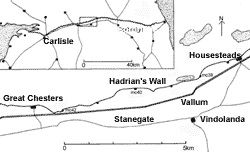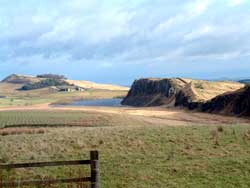
Click on the image for a larger version.
|
Image
details:
The location of Vindolanda in relation to
the Stanegate and Hadrian's Wall. Nearby forts and milecastles
are indicated.
Image ownership:
© Vindolanda Trust |
In 40 years of campaigning following the invasion of Britain in
AD 43, Roman power was extended as far as north-east Scotland. The
campaign culminated in AD 82/83 in the victory of Roman troops under
the command of the provincial governor, Agricola, over the Caledonian
tribes, at the unlocated battle site of Mons Graupius. Agricola
was subsequently recalled to Rome and military expansion ended.
For the Roman historian Tacitus, Agricola's son-in-law, this represented
a lost opportunity to conquer all the island: 'Britain was subjugated
and immediately let slip'. Northernmost Britain was never conquered,
although several later emperors desiring to gain a military reputation
tested their hand against the Caledonian peoples.
When Agricola's involvement with Britain ceased, so did his biographer's
interest in the province, and we lose our main witness to events.
One of the four legions was transferred to the Danube. Perhaps because
the army was over-extended in garrisons across Wales, northern England
and Scotland, it withdrew south from Scotland to the Tyne-Solway
isthmus by the last decade of the first century AD. The 'Stanegate',
the road connecting Carlisle and Corbridge as well as forts and
fortlets on its route, including Vindolanda, was perhaps a provisional
frontier. The reign of the emperor Trajan (AD 98-117) and the early
part of the reign of his successor, Hadrian (AD 117-138), was a
period of obscure wars in Britain. According to the later biographer
of Hadrian, 'the Britons could not be kept under control'. Re-used
in the praetorium of the late Roman fort at Vindolanda was a tombstone
recording the death of Titus Annius, centurion of a cohort of Tungrians,
perhaps the first cohort, one of the Vindolanda garrisons in the
pre-Hadrianic period. It refers to his death in a war (bellum)
which may be one of these obscure conflicts.

Hadrian's Wall above Crag Lough The Wall runs along the crags above the Lough from the right. It runs behind the farm (past milecastle 38), and rises up Hotbank Crags
Click on the image for a larger version.
|
Image
details:
Hadrian's Wall above Crag Lough The Wall
runs along the crags above the Lough from the right. It runs
behind the farm (past milecastle 38), and rises up Hotbank
Crags
Image ownership:
© Vindolanda Trust |
These wars explain the next major development on Roman Britain's
northern frontier, the building of Hadrian's Wall. Hadrian visited
Britain in AD 122 on a journey that took him to most of the frontiers
of the Roman world. Little is recorded of the circumstances or Hadrian's
motives: according to a later biography he built the wall 'to divide
the Romans from the barbarians'. Responsibility for building fell
to Aulus Platorius Nepos, the governor of Britain. Building began
in AD 122, although before even it had been completed to the original
design, the modifications and adaptations had begun. The legions
built the wall but the auxiliaries garrisoned it. They were initially
stationed in the forts behind the wall on the Stanegate, like Vindolanda.
This arrangement was rapidly recognised as unsatifactory, since
troops were soon moved up to forts on the line of the wall itself,
half a day's march apart. Vindolanda however continued to be occupied.
|